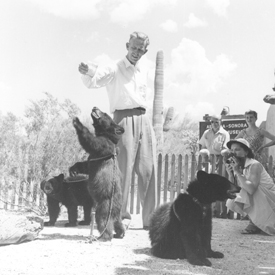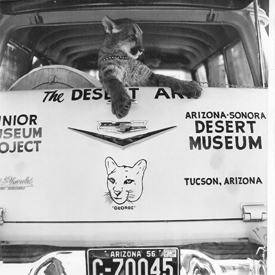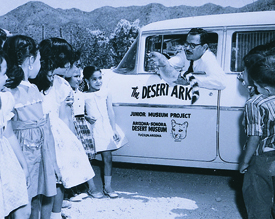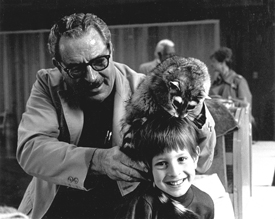Hal Gras and Animal Names
Hal Gras was first employed by the Desert Museum on October 19, 1953, when he hosted the Museum's first television program, Desert Trails. By the time he retired in 1985, Hal had presented 1,551 Desert Trails programs and 5,382 Desert Ark programs.
The Desert Ark program which Hal presented to school groups and organizations was unique. He was friendly, entertaining, dedicated, hard-working, and a showman. He captured children's attention and admiration, and adults soon found themselves drawn in and enjoying Hal's presentation as much as the children.
Hal stated the purpose of the Desert Ark programs. "combating fear and ignorance with the truth, presented in as entertaining a fashion as possible, the Desert Ark animals through their routines strive to promote a basic respect for all living things, including human beings. People do not knowingly destroy the things they respect — what better, more effective way is there to attract a child's attention than with a live animal whose existence can somehow be related to that child's own life?"
The Desert Ark program featured all kinds of animals from snakes and pack rats to young mountain lions and bears, and almost full-grown javelina. As he took an animal out of its carrying cage or bag in front of his audience Hal would talk about the animal's way of life, its place in nature, our human responsibility to the animals and the environment in which they live, and he somehow tied the animal to children's life experiences, perceptions of themselves, and their attitudes toward others.

Lew Walker and the Museum's first three bears |

Mountain Lion posing as George in Ark |
Hal was shamelessly anthropomorphic where his animals were concerned. He gave them names and oftentimes attributed some human qualities to them. He had a whole herd of javelina names. There were Gregory Peccary, Olivia de Javelina, Zsa Zsa La Boar, and Francis Bacon. The gopher snake was Julius Squeezer. Skunks were named Chlorophyll or Chlorophyllis, depending on gender. The pack rat or wood rat was named Woodrow Dent. Due to an accident when he was young in which he lost a portion of his tail, his middle name was "Acci."
A bobcat who was somewhat difficult when Hal first obtained him was "Diablo." La Vaga (the little traveler or runaway) was the name for Hal's first and subsequent ringtails. The original La Vaga was found soon after birth in a mothballed plane at Davis Monthan. Quilly Mays was born by porcupine caesarian section after his mother was killed by a car on a road in Fort Huachuca. Quilly starred in more than 3000 Desert Ark programs, including two at the White House.
Bill Carr stated, "Hal Gras has brought more people through the gate than any other individual." A fan once observed, "Hal Gras talked to the animals and at times it seemed they talked back." And a reporter cut to the essence of the Ark under Hal Gras, "Admittedly Hal is a showman and stagecraft and putting porcupines on a first name basis is only a tool for the deeper purpose of making the desert instantly interesting and eminently worth safeguarding."

Hal, Desert Ark and children |

Hal and La Vaga (the Davy Crockett act) |
There were numerous George L. Mountainlions (the name given by Bill Carr), plus the Georges that followed.
Female lions included Suzy (our first mountain lion, who was shipped to a different home after she failed to get along with George I; Georgette; Baby; Elsie; and Honey (given by the ranchers who raised her). The same ranchers raised her brother; they named him Tom and he became George IV.
The first three bear cubs at the Museum were named Smoky I, Smoky II, and Smoky III.
Two orphaned bobcat kittens being raised at ASDM in 1953 were Whiskers and Buttons.
Min and Gus were pronghorn twins born at the Museum
ASDM's first big horn sheep was Chivito, named by the Mexican ranch family which first raised him.
Tommy was ASDM's first resident bobcat. Earlier he had starred in Disney's Living Desert film.
There was Pantano, a badger, that Hal had, and another he called B.B. (I don't have an explanation for that one). Ida was the name given to the Museum's first badger (or for this one).
Three roadrunners were Goofy, Goony, and Gander. Rooney was a kangaroo rat. El Tigre was the first jaguar (probably named by Lew Walker).
In regard to naming animals and giving them some human characteristics, Bill Carr wrote, "In connection with our education policy, how do we handle the proposition of attributing human behavior and traits to non-human animals in the course of verbally instructing visitors? We certainly do not overdo anthropomorphism, neither are we afraid of it... we do consciously use an anthropomorphic approach to some of our teaching, especially with children, distinctly as the essential means to a desired end."